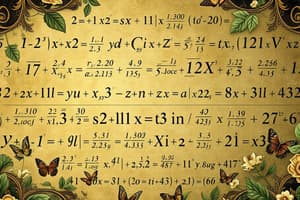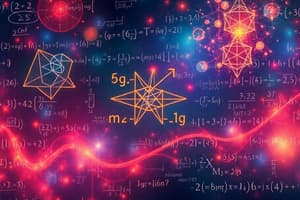Podcast
Questions and Answers
What is a missing number in algebra?
What is a missing number in algebra?
In algebra, it can appear many times.
Which of the following are operations in mathematics?
Which of the following are operations in mathematics?
- Addition (correct)
- Multiplication (correct)
- Subtraction (correct)
- Division (correct)
What are variables used for in algebra?
What are variables used for in algebra?
Variables are used instead of a question mark when representing missing numbers.
What defines an equation?
What defines an equation?
What is an expression in algebra?
What is an expression in algebra?
What is a solution?
What is a solution?
What are equivalent equations?
What are equivalent equations?
What is the golden rule of algebra?
What is the golden rule of algebra?
What are inverse operations?
What are inverse operations?
What does the commutative property state for addition and multiplication?
What does the commutative property state for addition and multiplication?
What are equivalent expressions?
What are equivalent expressions?
What is interest as defined in banking?
What is interest as defined in banking?
What is the rate of change?
What is the rate of change?
What defines a negative number?
What defines a negative number?
What defines a positive number?
What defines a positive number?
What is a number line?
What is a number line?
What is an opposite number?
What is an opposite number?
The order of operations is ______.
The order of operations is ______.
What does 'undo in reverse order' refer to?
What does 'undo in reverse order' refer to?
What is the associative property?
What is the associative property?
What are terms in algebra?
What are terms in algebra?
What does simplifying mean?
What does simplifying mean?
What does combining coefficients involve?
What does combining coefficients involve?
Rate is defined as ______.
Rate is defined as ______.
What is the distributive property?
What is the distributive property?
What is a false equation?
What is a false equation?
What is an identity in algebra?
What is an identity in algebra?
What is the numerator?
What is the numerator?
What is the denominator?
What is the denominator?
What does factoring refer to?
What does factoring refer to?
What are prime numbers?
What are prime numbers?
What is a rational expression?
What is a rational expression?
What is a proportion?
What is a proportion?
What is a ratio?
What is a ratio?
What is an exponent?
What is an exponent?
What is the base in exponentiation?
What is the base in exponentiation?
What are like terms?
What are like terms?
What is advanced distributing?
What is advanced distributing?
What is a monomial?
What is a monomial?
What is a binomial?
What is a binomial?
What is a trinomial?
What is a trinomial?
What is a polynomial?
What is a polynomial?
What does the radical sign indicate?
What does the radical sign indicate?
What is a root in mathematics?
What is a root in mathematics?
What are radical equations?
What are radical equations?
What is an irrational number?
What is an irrational number?
What is a rational number?
What is a rational number?
What defines a real number?
What defines a real number?
What is a right triangle?
What is a right triangle?
What is the Pythagorean Theorem?
What is the Pythagorean Theorem?
Flashcards are hidden until you start studying
Study Notes
Algebra Fundamentals
- Missing Number: Represents unknown values in algebra, appearing multiple times.
- Operations: Key arithmetic functions: addition, multiplication, subtraction, division.
- Variables: Symbols used in place of numerical values to denote missing numbers.
Equations and Expressions
- Equation: Consists of two sides with an equal sign, indicating equivalence.
- Expression: Combination of numbers and variables without an equal sign.
- Solution: The value that satisfies an equation.
Properties of Equations
- Equivalent Equations: Different forms of equations that yield the same solution.
- Golden Rule of Algebra: Altering one side of an equation necessitates a corresponding change on the other side.
- Inverse Operations: Pairs of operations that cancel each other (e.g., multiplication vs. division).
Mathematical Properties
- Commutative Property: The order of addition or multiplication does not affect the result (a+b = b+a, ab = ba).
- Associative Property: The way numbers are grouped in addition or multiplication does not change the outcome ((a+b)+c = a+(b+c)).
- Distributive Property: Distributing multiplication over addition (a(b+c) = ab + ac).
Numbers and Operations
- Negative Number: A number less than zero.
- Positive Number: A number greater than zero.
- Terms: Components of expressions, including individual numbers and variables.
Fractions and Ratios
- Numerator and Denominator: The top and bottom parts of a fraction, respectively.
- Rational Numbers: Numbers expressible as a fraction of whole numbers.
- Irrational Numbers: Cannot be expressed as fractions; have non-repeating, non-terminating decimal expansions.
Advanced Mathematics
- Polynomial Types: Monomial (one term), binomial (two terms), trinomial (three terms).
- Factoring: The process of expressing a number or expression as a product of its factors.
- Radical Equations: Equations that include square roots or other roots.
Graphs and Geometry
- Number Line: A visual representation of numbers in a linear format.
- Rate of Change: Measurement of how a quantity changes relative to another variable, often time.
Special Concepts
- Pythagorean Theorem: Fundamental relationship in right triangles; states that the square of the hypotenuse equals the sum of the squares of the other two sides.
- Like Terms: Terms in an expression that have the same variable raised to the same power; can be combined.
- Exponent: Indicates how many times a number is multiplied by itself; represented as a superscript.
Summary of Process
- Order of Operations: The rules that dictate the sequence in which operations are performed (Parentheses, Exponents, Multiplication and Division, Addition and Subtraction, abbreviated as PEMDAS).
- Simplifying Expressions: The act of rewriting expressions in a more manageable or concise form by combining like terms or performing operations.
Studying That Suits You
Use AI to generate personalized quizzes and flashcards to suit your learning preferences.




